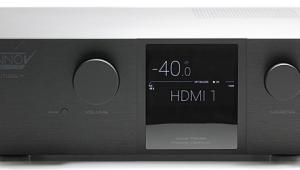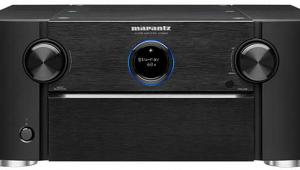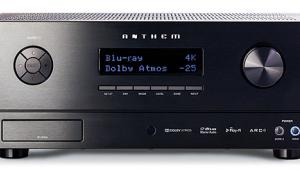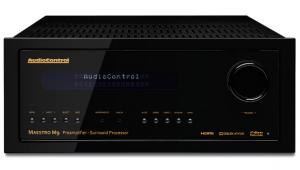Parasound Halo P 7 Multichannel Preamplifier, A 51 Multichannel Amplifier & JC 1 Single-Channel Amplifier HT Labs Measures
Parasound Halo P 7 Multichannel Preamplifier
Analog frequency response in Tone Off mode:
–0.05 dB at 10 Hz
–0.01 dB at 20 Hz
–0.15 dB at 20 kHz
–0.99 dB at 50 kHz
Analog frequency response with Tone On, controls zeroed:
–0.15 dB at 10 Hz
–0.24 dB at 20 Hz
–0.49 dB at 20 kHz
–1.43 dB at 50 kHz
The chart below shows the frequency response of the left channel from balanced input to balanced output in Tone Off mode.

Response from the multichannel input to the main output measures –0.05 decibels at 10 hertz, –0.01 dB at 20 Hz, –0.08 dB at 20 kilohertz, and –0.56 dB at 50 kHz. The analog THD+N was less than 0.025 percent at 1 kHz with a 100-millivolt input and the volume control set to 86. Crosstalk with a 100-mV input was –90.29 dB left to right and –91.31 dB right to left. The signal-to-noise ratio with “A” weighting was –120.48 dBrA. —MJP
Parasound Halo A 51 Multichannel Amplifier
Two channels driven continuously into 8-ohm loads:
0.1% distortion at 301.1 watts
1% distortion at 330.6 watts
Five channels driven continuously into 8-ohm loads:
0.1% distortion at 198.7 watts
1% distortion at 238.4 watts
Frequency response RCA input:
–0.04 dB at 10 Hz
–0.01 dB at 20 Hz
–0.09 dB at 20 kHz
–2.94 dB at 50 kHz
Frequency response XLR input:
–0.04 dB at 10 Hz
–0.01 dB at 20 Hz
–0.08 dB at 20 kHz
–2.99 dB at 50 kHz

This graph shows that the A 51’s left amplifier channel, with two channels driving 8-ohm loads, reaches 0.1 percent distortion at 301.1 watts and 1 percent distortion at 330.6 watts. Into 4 ohms, the amplifier reaches 0.1 percent distortion at 357.2 watts and 1 percent distortion at 422.8 watts. An input level of 102.2 millivolts was required to produce an output of 2.83 volts into an 8-ohm load, indicating an overall gain of +28.87 decibels using the RCA input. When using the XLR input, a level of 105.1 millivolts was required to produce an output of 2.83 volts into an 8-ohm load, indicating an overall gain of +28.62 dB.
THD+N from the amplifier was less than 0.015 percent at 1 kilohertz when driving 2.83 volts into an 8-ohm load using the RCA input. When using the XLR input under the same conditions, THD+N was less than 0.015 percent. Crosstalk at 1 kHz driving 2.83 volts into an 8-ohm load was –93.34 dB left to right and –94.94 dB right to left using the RCA inputs and –100.64 dB left to right and –96.79 dB right to left using the XLR inputs. The signal-to-noise ratio with an 8-ohm load from 10 Hz to 24 kHz with “A” weighting was –99.03 dBrA using the RCA input and –99.30 using the XLR input. —MJP
Parasound Halo JC 1 Single-Channel Amplifier
One channel driven continuously into an 8-ohm load:
0.1% distortion at 499.1 watts
1% distortion at 582.4 watts
Frequency response RCA input:
–0.03 dB at 10 Hz
+0.00 dB at 20 Hz
–0.11 dB at 20 kHz
–3.44 dB at 50 kHz
Frequency response XLR input:
–0.04 dB at 10 Hz
+0.00 dB at 20 Hz
–0.22 dB at 20 kHz
–3.60 dB at 50 kHz

This graph shows that the JC 1 in High Bias mode, driving an 8-ohm load, reaches 0.1 percent distortion at 499.1 watts and 1 percent distortion at 582.4 watts. Into 4 ohms, the amplifier reaches 0.1 percent distortion at 608.7 watts and 1 percent distortion at 835.9 watts.
An input level of 100.5 millivolts was required to produce an output of 2.83 volts into an 8-ohm load, indicating an overall gain of +29.00 decibels using the RCA input. When using the XLR input, a level of 101.5 millivolts was required to produce an output of 2.83 volts into an 8-ohm load, indicating an overall gain of +28.92 dB.
THD+N from the amplifier was less than 0.004 percent at 1 kilohertz when driving 2.83 volts into an 8-ohm load using the RCA input. When using the XLR input under the same conditions, THD+N was less than 0.007 percent. The signal-to-noise ratio with an 8-ohm load from 10 hertz to 24 kHz with “A” weighting was –109.45 dBrA using the RCA input and –103.88 using the XLR input. —MJP




























































